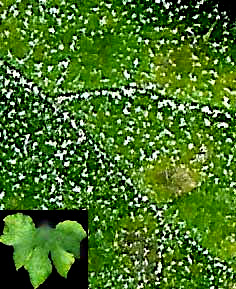(SOURCE: NCBI database)
KINGDOM: Fungi
DIVISION: Ascomycota
CLASS: Leotiomycetes
ORDER: Erysiphales
FAMILIES: several

At the left you see some very sick-looking Flowering Dogwood leaves. Powdery mildew on dogwoods is caused by various fungus species in the genera Microsphaera and Phyllactinia.
In the picture, newly developed spring leaves are pale, puckery, and appear to be covered with a white dust or powder. The close-up at the lower right shows that there's not much to this white stuff -- it really is like powder. The powder consists of fungal mycelia and asexually produced, conidia-type spores.
Powdery mildews seldom kill their hosts but they do stress them, impairing growth and development. Along with rusts, powdery mildews are probably the most common, widespread and recognizable plant diseases. Hundreds of fungus species produce the disease, to which over 10,000 species of flowering plants are susceptible. All but a few of the fungal organisms live on the outside of their hosts; They're "ectoparasitic."
Powdery mildew species reproduce sexually and asexually. The white powder in the picture shows the asexual stage. During the sexual stage, a microscophic, closed structure called a cleistothecium forms among the mycelia. Unlike many sac fungi, whose spores are released at the tips of spore-containing asci, these cleistothecia have no openings, and release their spores only when the cleistothecia decay or disintegrate. Cleistothecia can overwinter, and when spring comes and they disintegrate, spores then can escape to infect new plants. In general, among powdery mildew species, the asexual, or conidial, stage serves to spread the disease and intensify its effects, while the sexual stage assures that the fungus species survives from one season to the next.

At the right is a close-up of another powdery mildew, this one Erysiphe cichoracearum, causing a late-summer mildew on the leaf of a yellow crookneck squash plant. The picture shows white mycelium and hyphae producing long chains of white, asexually produced, conidia-type spores on the leaf's sunny, upper surface.